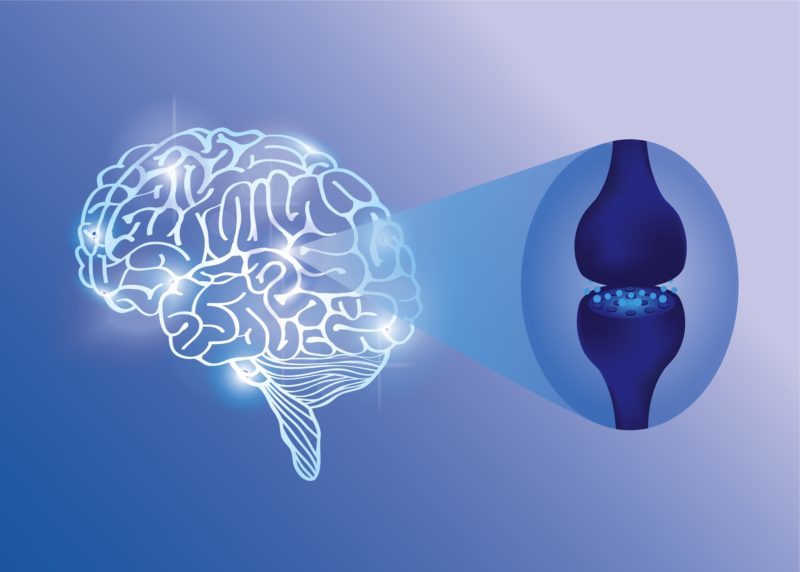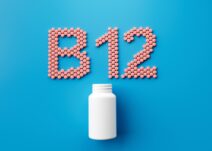If the biological action of cannabinoids is a new subject to you, let’s begin with a few facts about hemp. First, hemp is not Marijuana. Hemp does not contain significant amounts of tetrahydrocannabinol (THC), the psychoactive compound in Marijuana. Secondly, hemp has been an important crop in the USA for its industrial and health uses since the early settlers of this country. U.S. Presidents including George Washington, Thomas Jefferson, James Madison, James Monroe, Andrew Jackson, Zachary Taylor, and Franklin Pierce grew hemp as a cash crop and for personal health use. Ben Franklin owned a paper mill that used hemp as a raw material for paper. Hemp has saved millions of trees from being cut down for paper.
Hemp has advantages over many materials and once was a multi-billion-dollar crop accounting for about 80% of textiles and fabrics. However, the Uniform State Narcotic Drug Act in 1934 and the Marihuana Tax Act of 1937 lumped hemp in with Marijuana, which led to falsely making hemp illegal. As a result, millions of citizens were not able to achieve their best health as they couldn’t optimize their ECS.
Fortunately, my colleague Carl Germano, CNS, CDN, has recently written a book that explains why cannabinoids are important for optimal health, so I have called upon him to chat with us.
Carl Germano, CNS, CDN, is a NY Board Certified Clinical Nutritionist and Vice President for Verdant Oasis. He holds a master’s degree in clinical nutrition from New York University and has over 37 years’ experience as VP of product development for several of the largest vitamin supplement companies in the trade. He is a prolific author with several bestselling trade books includingThe Misled Athlete, Nature’s Pain Killers, The Osteoporosis Solution, The Brain Wellness Planand his most recentRoad To Ananda: The Simple Guide To The Endocannabinoid System, Phytocannabinoids & Your Health.He has also held a progressive nutrition practice at The Nutrition Therapy Center in New York and is a frequent lecturer and radio guest.
Passwater:Well, it has been a quite a while since I have collaborated in this column with my old colleague and friend Carl Germano, CNS, CDN. Far too long. He has always been ahead of his time and an interesting and informative lecturer.
Carl, you have written a new book called “Road To Ananda: The Simple Guide To The Endocannabinoid System, Hemp Phytocannabinoids, and Your Health.” You have written several groundbreaking books over the years, and this book undoubtedly covers one of the most important topics for this decade and many to come. Please provide a glimpse as to this subject and its importance.
Germano:Thank you for your kind words and thank you for the decades of education, contributions and support you have given so many—it is truly a pleasure to be your friend. The subject of cannabinoids, while controversial, has always intrigued me and the way hemp (Cannabis sativa L.) has been mistreated in the U.S. for the past 80 years has served as a springboard for me to further investigate the science and unravel the truth about this plant. It is without question that hemp signifies the most important botanical on this planet. Its active class of compounds called phytocannabinoids (CBD being only 1 of almost 100 phytocannabinoids in hemp) represents the most important, clinically relevant plant compounds to come to the marketplace since the inception of this industry. Figure 1 shows several cannabinoids.
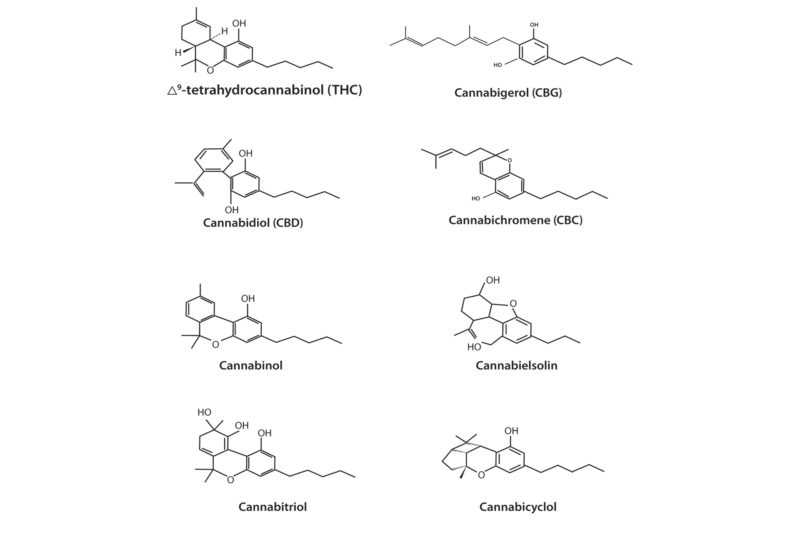 Passwater:That covers a lot of ground.
Passwater:That covers a lot of ground.Germano:I make such a bold statement based on the fact that phytocannabinoids help to influence and support one of the most important physiological systems in the human body called the Endocannabinoid System (ECS).
Passwater:As important as the ECS is, many readers are not familiar with it yet. Please explain a little about the ECS and why it is so important.
Germano:The ECS is composed of cannabinoid receptors (CB1, CB2, and others presently being investigated) and the components that attach to them called endocannabinoids (anandamide and 2-AG). Our CB1 and CB2 receptors are doorways into the cell to pass on information activated by endocannabinoids. While anandamide and 2-AG initiate activity to the CB receptors found on every organ, they are quite promiscuous in that they influence other receptors such as the GABA, 5HT3, PPARS, TRP, opioid, and endorphin receptors as well. (Please see Figures 2 and 3.)
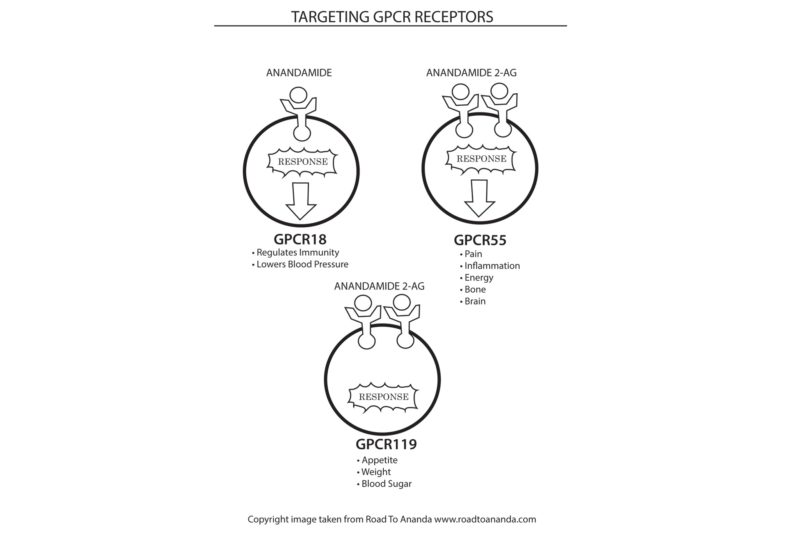
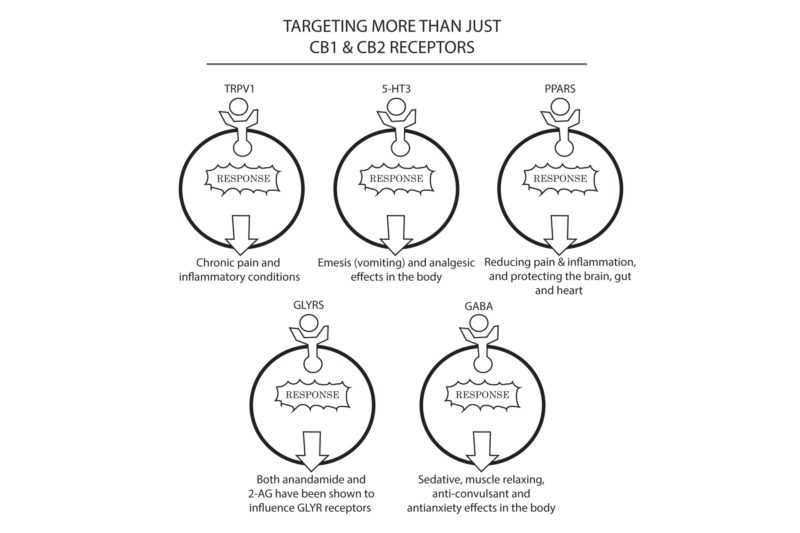
Globally, the ECS acts as the conductor of the beautiful symphony of intricate communication that occurs between organs and cells throughout the entire body. (Please see Figure 4.) There is no physiological function that is not influenced by the ECS. Its proper support is essential to maintain health and its dysregulation is associated with numerous disease conditions. Unfortunately, due to the stigma attached to cannabinoids, the ECS has been buried since the 1990s and there has been little to no education or research conducted here in the U.S. In December 2018, the Farm Bill was signed into law that deregulated hemp and we are just beginning to unravel the stigma and begin the process of education and research into the ECS.
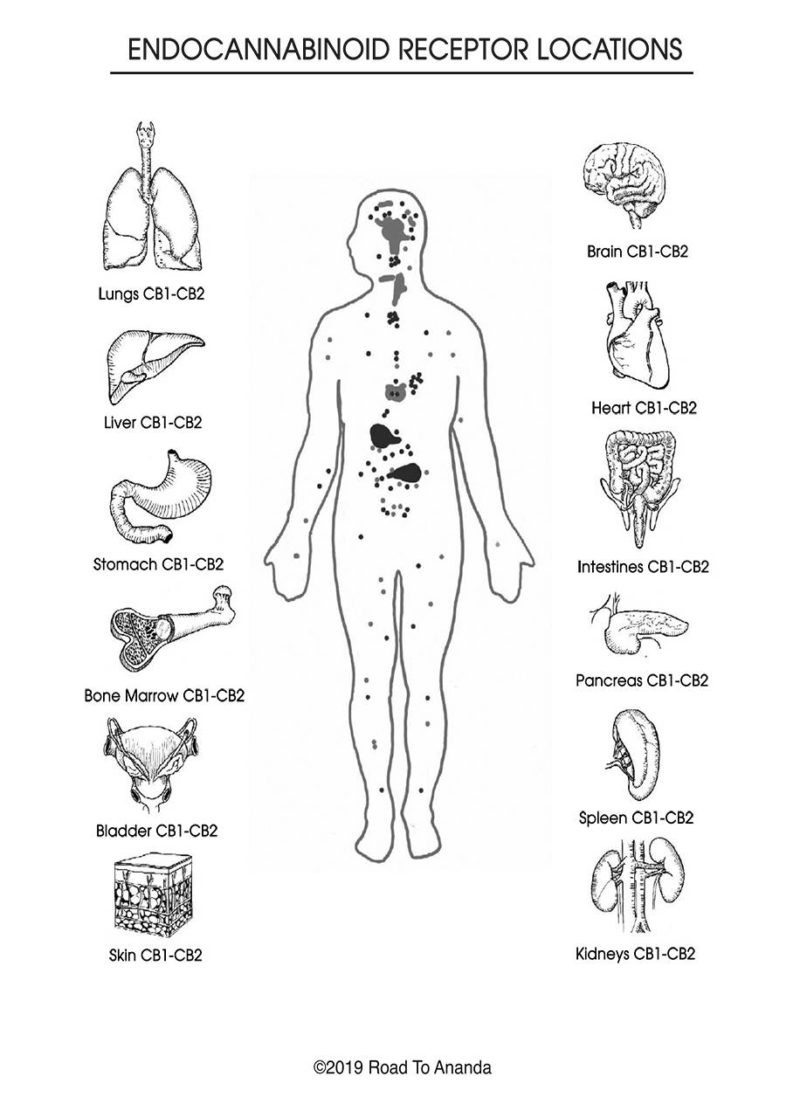
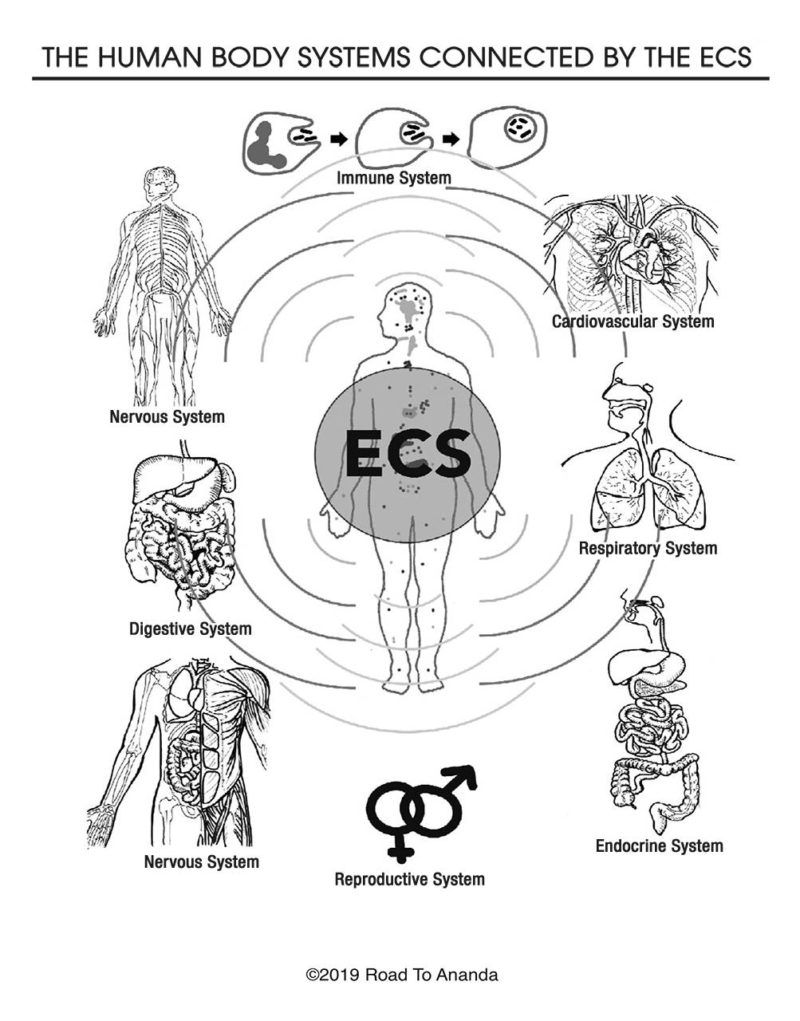
Unfortunately, decades of stifled education and research on hemp, phytocannabinoids, and the ECS has represented both a travesty and tragedy in medicine. Therefore, in order for people to embrace and understand phytocannabinoids such as cannabidiol (CBD), it is crucial to understand how they influence and support the ECS. Road To Ananda (roadtoananda.com) was necessary for me to write so that people can begin the journey into this very subject.
Passwater:Your book is indeed an excellent road to the ECS scientific literature, and you make it easy for the non-scientist as well as the scientist to understand. There are many faces behind its discovery. Who has been your inspiration on this subject and why is it so important?
Germano:While the U.S. has been in the dark ages regarding the ECS, hemp and phytocannabinoids, Israel and Europe have been championing research on the ECS as well as cultivation and commercialization of hemp. The 1990s happened to be a most important decade of discovery for the ECS, and at the helm of this unearthing was the work of Dr. Raphael Mechoulam at Hebrew University in Jerusalem. He has been my source of inspiration in this field. He is best known for his work on the isolation and synthesis of THC (tetrahydrocannabinol) as well as the cannabinoids we produce in the body(endocannabinoids) called anandamide and 2-AG (2-arachidonylglycerol). He has been called the “Father of Cannabinoid Research” and has published over 350 scientific articles and the recipient of numerous prestigious awards. In addition, there were several of his colleagues that played instrumental roles in the discovery of the ECS and its inner workings including Hanus, Devane, Howelett, and Herkenham who collectively belong on what I call Mt. Hempmore. (Please see Figure 5.)
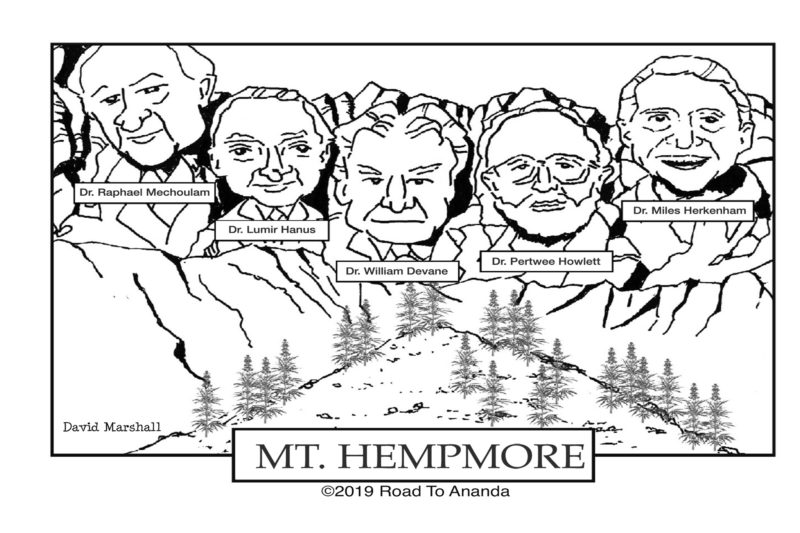
Passwater:I notice that he wrote an Introduction to your book.
Germano:Yes. While there were several players involved in the discovery of the ECS, Dr. Mechoulam stands out the most. Due to its role in modulating most, if not all, physiological functioning in the body, the ECS is one of the most important medical discoveries in quite some time. Thanks to Dr. Mechoulam’s work and many others around the world, we are getting closer to unraveling the enormous potential of how supporting the ECS can impact health and its usefulness in preventing and treating diseases. From the earliest moments of development to the last stages of your life, your ECS is involved in constant mass communication with every organ system in your body and intimately involved with modulating their activity.
Passwater:Briefly, in what ways? We’ll discuss this in more detail later.
Germano:Through its communication with all organ systems, the ECS helps regulate all biological functions, including your appetite, digestion, immune function, inflammation, motor control, mood, memory, sleep, etc. It does so by influencing various intricate pathways that the CB, TRVP, GABA, 5HT3, etc. receptors control. At the cellular level, the ECS exerts numerous regulatory roles too lengthy for this article, but here is a glimpse:
Brain:The ECS governs neurotransmission, brain cell development, mood and memory, and provides antioxidant and anti-inflammatory effects that help protect the brain from further damage after trauma or stroke.
Metabolism:The ECS governs energy storage, involved in energy production, insulin sensitivity.
Stress:The ECS regulates the HPA pathway by altering stress response hormones.
Bone:The ECS influences brain to bone communication, suppresses osteoclast activity (cells that break down bone) and stimulates osteoblasts (cells that build up bone).
Inflammation/Pain:The ECS is intimately involved in nociceptive pain signaling to the brain and as well as being intertwined in many inflammatory pathways including the eicosanoid pathways that omega 3’s influence.
Anxiety/Depression:The ECS exerts its regulatory effects on various hormones and neurotransmitters involved in the development of several psychological pathologies.
Passwater:Many people will be surprised to learn that their bodies produce cannabinoids. About how many naturally produced compounds in the body activate the cannabinoid receptors, and are any of the phytocannabinoids produced in hemp bioidentical (the same) as cannabinoids produced in the human body?
Germano:In addition to anandamide and 2-AG, other lipid-based molecules have also been classified as endocannabinoids due to their effects on cannabinoid receptors including arachidonoyl dopamine, virodhamine, palmitoyl ethanolamide, oleoylethanolamide, and several byproducts of omega-3 fatty acids. Which brings us to an important relationship between omega-3s and the ECS. Several papers have been published to demonstrate this intimate relationship. Basically, when you are omega-3 deficient, your ECS suffers and we see the same conditions as those who are endocannabinoid deficient—pain/inflammation, stress/anxiety, etc. With omega-3 deficiency, your CB receptors are not as active, and omega-3s are used as backbone materials to produce cannabinoids in the body. Therefore, it makes sense to take omega-3s when taking hemp phytocannabinoids—the collectively serve as a “multivitamin” for your ECS.
Passwater:What happens when they don’t produce enough cannabinoids?
Germano:They are so important that when we don’t produce enough, disruption in the normal state (homeostasis) occurs and sets the stage for acute and chronic conditions. In certain ways, our endocannabinoids serve as biomarkers and are associated with certain disorders when their levels are too low. Stress, anxiety, pain, inflammation, insomnia, eye health, bone health, neurological maladies are conditions where we see depressed levels of endocannabinoids requiring dietary ECS support. Clinically, we are seeing that utilizing hemp phytocannabinoids serves as the foundation for any nutritional protocol addressing these issues. Dr. Ethan Russo’s papers on this very subject provides greater insights into conditions such as migraines, fibromyalgia, irritable bowel syndrome, and many other disorders associated with inflammatory and neurological origins to be what he called Endocannabinoid Deficiency states—all of which can be suitably treated by providing dietary phytocannabinoids. Hemp happens to be the richest and most important source!
Passwater:Disruption of homeostasis opens up one’s susceptibility to illness and the ECS plays a pivotal role in maintaining health, balance, and well-being. With that said, we have been hearing a lot about CBD these days and wondered how it fits in to supporting the ECS. What are your thoughts?
Germano:Homeostasis is critical to the body and your ability to adapt to the daily bombardment of stressors. When your ECS is not supported properly, you enter a state of imbalance that can jeopardize your health and well-being and set the stage for illness. In order to support the ECS, it is the entire family of phytocannabinoids that are required, and no single one can properly do so—this includes CBD!
CBD has been popularized due to the significant results achieved in trials on treating epilepsy and cancer therapy induced symptoms utilizing GW Pharmaceuticals FDA approved drugs that contain isolated CBD. Unfortunately, some companies have been trying to follow the popularity and media attention of CBD by big pharma and have myopically focused on single magic bullet CBD only. This is quite a disappointment for so many reasons. First, when has the dietary supplement industry ever followed big pharma’s single magic bullet approach to health and disease treatment—NEVER! So, why begin here? With all the botanicals sold in the industry, have we ever just focused on one compound in a plant? The answer is simply no.
There is not just one ginsenoside in ginseng, there is not just one curcuminoid in curcumin, there is not just one ginkgolide in ginkgo, etc.—I can go on, but you get the point. So, knowing there are close to 100 different phytocannabinoids in hemp, why in the world do we think that the only clinical relevancy of hemp is due to one phytocannabinoid—CBD? Those of us in botanical medicine know very well that the synergy of all compounds in a botanical is more important than singling out just one—no difference with hemp.
Dr. Ethan Russo wrote an eloquent paper on this very subject that was published in theBritish Journal of Pharmacologywhere he discussed how all of the phytocannabinoids in cannabis have unique properties that contribute to their clinical benefits and are greater than any single magic bullet approach. So, why all the attention given to just CBD when we know there are so many other phytocannabinoids that are equal to or have greater activity than CBD? There is no answer or excuse to focus just on CBD—period! Some of the more important synergistic players such as cannabigerol (CBG), beta caryophyllene (BCP), the cannabis flavonoids (CannFlavin A, B & C), and many others will share the spotlight as more research is unravelling their effects in the body. The bottom line is that the importance of the entire class of hemp phytocannabinoids and how they support the ECS should have been the lead-out story.
Unfortunately, it is bad enough that the U.S. government has misled us for the past 80 years, now we have been misled by companies trying to minimize the story and make it just about CBD, diminish hemp’s importance and efficacy of all of its phytocannabinoids, and insulting our intelligence by shoving the myopic CBD story down our throats.
Passwater:With many focusing on inflammation and stress, what are some of the more interesting conditions where the ECS is involved in?
Germano:With data supporting the role of the ECS in inflammation/pain, stress/anxiety, sleep, ocular health, bone support, and neurological conditions, emerging data reveals applications of hemp phytocannabinoids in addressing the GUT/brain/immune connection—a subject I covered in my bookThe Brain Wellness Planmany years ago. We know the ECS regulates motility and inflammation in the GI tract, but new studies demonstrate an interesting role for our endocannabinoids assisting with foreign antigen tolerance, HPA stress pathway, and immune response in our GUT—the largest immune organ in the body! In addition, what is unraveling is a major communication in the GUT between our microbiome and what I call the endocannabidiome.
It seems that probiotics and our endocannabinoids and receptors are involved with an intimate dance of communication to keep the GUT/brain/immune system functioning properly—a system that is crucial in maintain health and prevent disease.
Another fascinating topic is the role of the ECS in consciousness. Knowing the ECS governs neurotransmission and is involved with all aspects of how we perceive the external environment, it is no stretch to understand the connections here. In general, our consciousness is tied into our thoughts, sensations, and feelings. Every conscious thought, perception or feeling and everything we think of or do is influenced in many ways by the level of endocannabinoid tone in the body.
In subtle ways, the ECS helps to form our personality—are you clear thinking, focused, laid back, relaxed, anxious, etc.—all this is due to the ECS and its regulatory roles in the brain. Lastly, the role of the ECS in sports medicine is about to explode. In my bookThe Misled Athlete,I cover many aspects of sports nutrition including energy production, reduction of inflammation, and recovery as major concerns to address nutritionally as opposed to stimulants and excess protein. Supporting the ECS with hemp phytocannabinoids will serve as a foundation to all nutritional protocols since is involved with ATP production, protecting mitochondria, reducing elevated inflammatory and oxidative markers after activity, and responsible for the “runners high.” Yes, you will have to rethink your thinking about feeling good after exercise being due to endorphins. We now know that elevated endocannabinoids influence the endorphin and opioid receptors responsible for the euphoric feeling after exercise.
Passwater:You and I have actively been involved in research and clinical practice for many decades and have witnessed the scientific/clinical story being diminished by not focusing on the entire class of phytocannabinoids. Nevertheless, the CBD story continues for now, yet legal issues abound. What are your thoughts?
Germano: I am thoroughly disappointed in the industry, legal counsel, and the FDA for letting an inept story and market develop the way it has. I am also perplexed by the complete dismissal by companies and legal counsel of a federal law you and I have been involved in back in 1994—the Dietary Supplement Health & Education Act (DSHEA). DSHEA law is very clear and tells us that if a substance has not been in commerce prior to 1994, it cannot be grandfathered as a dietary supplement.
CBD has not been in commerce prior to 1994, yet hemp and its naturally occurring class of phytocannabinoids have been as a food ingredient—strike one against CBD on a label being called a dietary supplement. The only option is to submit a New Dietary Ingredient (NDI) application to FDA for CBD. Why has no company submitted such? Probably due to the other clause in DSHEA that states if a pharmaceutical company takes a natural substance and obtains FDA approval as a drug, it’s hands-off to the dietary supplement industry. Well, GW Pharmaceuticals has done just that with its approved Epidilox drug with isolated CBD in it—strike 2 against CBD being a dietary supplement.
While there are some that make the case that CBD was on the market before GW’s approval, I have yet to see this challenged. Even if this was the case, you still have the issue that CBD was not in commerce prior to 1994—back to square one! So, while the scientific/clinical case was made in favor of phytocannabinoids as a naturally occurring class of compounds in hemp over single magic bullet CBD, so is the case legally. Why are we trying to waste our time fighting an uphill battle with the FDA about getting CBD approved as a dietary supplement? Unless FDA is planning to change or dismantle DSHEA, it is futile and wasting a great deal of time and money. Rather, the industry should be embracing hemp as a botanical, phytocannabinoids as the most important class of naturally occurring plant compounds, and how to nourish/feed/support the body’s endocannabinoid system. Lastly, FDA needs to enforce DSHEA and the simplistic and inaccurate CBD story will go away and make room for the more important story to be told.
Passwater:So, how best do we support our ECS and do we rely only on hemp?
Germano:While I have been telling people to get over the fact that we produce cannabinoids in the body, similar to some of the ones found in hemp, they are equally shocked by the fact that we have been eating phytocannabinoids in the diet! While hemp is undoubtedly the richest source of phytocannabinoids in the diet, there are other foods where they may be found. Yes, carrots, hops, chocolate, Echinacea, pepper, clove, thyme, etc. are all foods that have minute levels of phytocannabinoids in them. I said minute, so don’t rely on them to truly have therapeutic value unless you either consume huge quantities or they have been standardized in certain foods.
Just placing milligram levels of some of these spices/foods in a product is nothing more than marketing hype and comical at best. Nevertheless, the best example of a truly beneficial phytocannabinoid in food that can be standardized in large quantities is beta caryophyllene (BC) as found in abundance in clove and unripe black pepper seeds. When standardized in specially processed oils, BC is a perfect complement to CBD since it attaches to the CB2 receptor that CBD does not. It is the CB2 receptor that is involved in bone building, inflammation and pain, insulin sensitivity, and many other functions. This is yet another example of the importance of having other phytocannabinoids present and not to rely on just CBD. CBD cannot support the entire ECS on its own—you need the full family present—period!
Passwater:With that said, what should consumers look for in products in this category?
Germano:First and foremost, they should get to know the strains that are being used in products. It is important to know if the strains have a history of proven use in humans prior to 1994 (DSHEA). The EU Commission has a website where you can see what strains have been used for human use for decades. These are strains that have been cultivated and consumed by humans and represent many decades of what true industrial hemp looks like. Also, they can request DNA analysis and proof that the strains are actually coming from true industrial hemp as opposed to the genetically manipulated “Frankenstein” marijuana hybrids that pervade our industry that have no history of human consumption.
In addition, are the products non-GMO, organic, Kosher, solvent free, and tested for all pesticides including Monsanto’s glyphosate? Are the products free of CBD isolate? CBD isolate is a drug yet is found in numerous products in the market—either directly or indirectly. I am amused by looking at chromatograms of products showing CBD to be 70%, 80, or 90+% calling themselves full spectrum oils. It is absurd to think that such products can be full spectrum and retailers/consumers need stop “drinking the Kool Aid” and be diligent about the products and companies they choose. Essentially, the term full spectrum has been diluted in the marketplace. Ask for chromatograms of the material that can be very telling about whether the oil is spiked with CBD isolate or come from marijuana hybrids.
Essentially, when millions of marketing dollars get spent by companies trying to follow the coattails of GW Pharmaceuticals CBD approved drug, it is apparent that botanical medicine, the science of the ECS, and the legal aspects that plague CBD got completely ignored. There are a lot of questionable companies out there that have no clue about the science nor the DSHEA law—it’s buyer beware at the moment until FDA does its job.
Passwater:Carl, you have been researching this topic for many years. Thanks for sharing your knowledge with us about the Endocannabinoid System and the health benefits of phytocannabinoids.WF

